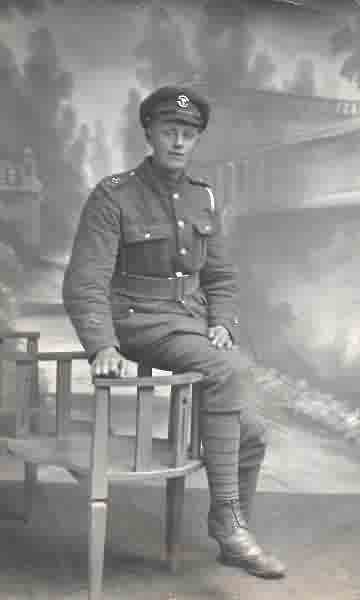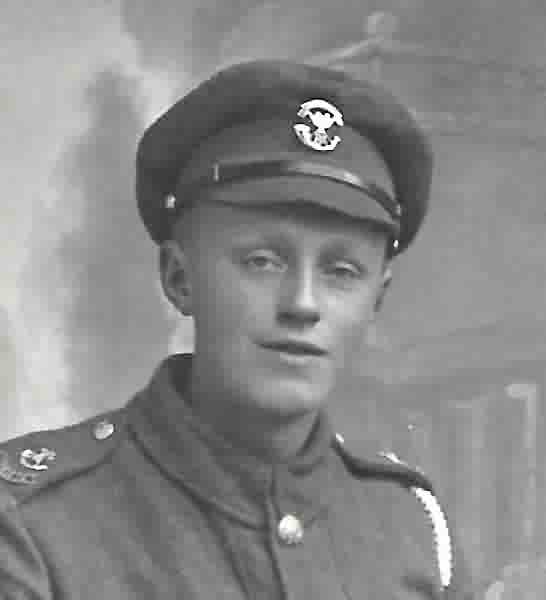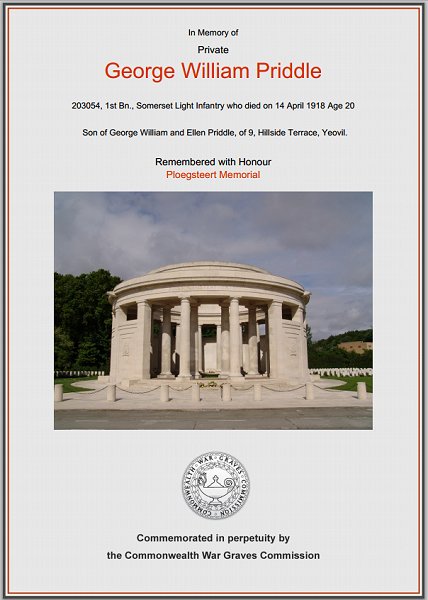yeovil at War
George William Priddle
Killed during an artillery bombardment
George William Priddle was born in Yeovil in 1898 the son of leather glove cutter George William Priddle (b 1872), originally from Lambrook, and Ellen née Bere (b 1876), originally from Dulverton. In the 1901 census George Snr and Ellen were living at 9 Hillside Terrace with 3-year old George and his baby sister Rhoda. The family were still living there in 1911 but by this time George had four sisters; Rhoda, Lorna, Thyra and Eileen. When he left school George worked as a printer for Whitby & Sons.
 Around
November 1916
George
enlisted in the
1st Battalion,
Somerset Light
Infantry at
Taunton. His
Service Number
was 203054 and,
after training,
he became part
of the Lewis
Machine Gun
Section of the
Battalion. He
was sent to
France with his
unit at the
beginning of
1917.
Around
November 1916
George
enlisted in the
1st Battalion,
Somerset Light
Infantry at
Taunton. His
Service Number
was 203054 and,
after training,
he became part
of the Lewis
Machine Gun
Section of the
Battalion. He
was sent to
France with his
unit at the
beginning of
1917.
In 1917 the 1st Battalion were at Arras, in action during the the First and Third Battles of the Scarpe, before heading north for the Third Battle of Ypres, where they fought in the Battle of Polygon Wood, the Battle of Broodseinde, the Battle of Poelcapelle and the First Battle of Passchendaele.
The Second Battle of Arras, fought between 9 April and 16 May 1917, was the British contribution to the Allied spring offensive of 1917. The original Allied plan for 1917, agreed at the Chantilly conference of November 1916, was for a second offensive on the Somme, but that plan was abandoned after a change of French leadership and it was decided that the British would attack around Arras and involve troops from three armies. In the north the Canadian corps of the First Army would attack Vimy Ridge. In the centre of the line the Third Army under General Allenby would attack from Arras. Finally, the British Fifth Army under General Gough would attack on the right of the line. The entire British attack was supported by 2,879 guns each of which had close to 1,000 shells. The British attack made impressive progress, but it did not achieve a breakthrough on the first day, allowing the Germans to rush their reinforcements into the gap and launch a series of counterattacks thereby slowing down the British attack. A renewed British attack at Bullecourt on 11 April failed to make any progress.
Field Marshal Sir Douglas Haig thought that Flanders presented a much more attractive target than the Somme as it was close to the main British sources of supply, was familiar to his staff and offered the chance of a breakthrough with targets such as the German railhead at Roulers and the Channel ports from which German submarines were conducting operations (he was under pressure from the Admiralty to clear the Flanders coast). The attack was preceded by the assault of Plumer's Second Army on Messines on 7 June 1917 with the main attack coming on 31 July from Gough's Fifth Army - a little too late as it happens for the momentum had been lost in the interval. It consisted of three phases - the first being the battles for Pilckem Ridge, Gheluvelt Plateau and Langemarck where the Fifth Army pushed its way into a salient made all the more boggy by unseasonal weather and the shelling had badly damaged the land drainage system. Secondly, Second Army took over with the battles for Menin Road Ridge, Polygon Wood and Broodseinde, making good progress in the central sector. Finally, in the battles for Poelcappelle and Passchendaele the attackers, who were by this time exhausted, fought their way onto Passchendaele Ridge in appalling conditions, with the Canadians taking the village on 6 November 1917. The British lost well over 200,000 men, with the Germans losing a similar figure and the battle badly affected the morale of both sides, with the word 'Passchendaele' becoming a byword for suffering.
The Battle of Polygon Wood, 25-27 September 1917, was part of the wider Third Battle of Ypres. It came during the second phase of the battle, in which General Herbert Plumer’s Second Army was given the lead. Plumer replaced the ambitious general assaults that had begun the battle with a series of small attacks with limited objectives – his “bite and hold” plan. These attacks involved a long artillery bombardment followed by an attack on a narrow front (2,000 yards wide at Polygon Wood). The attacks were led by lines of skirmishers, followed by small infantry groups. German strong points were to be outflanked rather than assaulted. Each advance would stop after it had moved forward 1,000-1,500 yards. Preparations were then made to fight off any German counterattack. The attack on Polygon Wood was the second of Plumer’s “bite and hold” attacks, after Menin Road. It was carried out chiefly by the 4th and 5th Australian Divisions but the 1st Battalion, Somerset Light Infantry also played a part. The target was a line just beyond Polygon Wood (a wood in name only by 1917, having lost all of its trees in earlier fighting). The site of Polygon Wood was captured on 26 September, the target line on 27 September. The attack then stopped, and Plumer prepared for the next attack. The two Australian divisions lost 5,471 men during the Battle of Polygon Wood. The three “bite and hold” attacks brought the front line to the foot of the Passchendaele Ridge, which would be come the target of the First and Second Battles of Passchendaele, and give its name to the entire battle.
The Battle of Broodseinde, 4 October 1917, was the last of three successful “bite and hold” battles launched by General Herbert Plumer during the middle phase of the Third Battle of Ypres. Both sides were planning an attack on 4 October. When the British bombardment began, it caught a number of German units out in the open preparing for their own attack. The British attack contained divisions from Britain, New Zealand and Australia. As at Menin Road Ridge and Polygon Wood, the British attack achieved its main objectives and then halted to dig in. Although these attacks are normally described as small scale battles, the casualty figures demonstrate the real scale of the fighting. The Germans suffered 10,000 casualties and lost 5,000 prisoners. On the Allied side the Australians suffered 6,432 casualties, the New Zealanders 892 and the British 300.
In 1918 the 1st Battalion saw action on the Somme, then returned to Flanders fighting in the Defence of Hinges Ridge during the Battle of Hazebrouck (12-15 April 1918). In the build-up to the Battle of Hazebrouck the German artillery began a massive bombardment as recalled in the Regimental History of the Somerset Light Infantry "On the night of 7 April a heavy and prolonged bombardment with gas shell was opened by the enemy along practically the whole front from Lens to Armentières. At 4am on the 9th the bombardment was renewed with savage fury, gas and explosive shells being poured on to the Allied lines in great quantities.... For several days the enemy pressed his attacks, using great numbers of troops." George Priddle was killed by an artillery shell on 11 April 1918. He was aged just 20.
On 3 May 1918 the Western Gazette reported "Mr GW Priddle, of 9 Hillside Terrace, has been informed that his son, Private George Wm. Priddle, of the Somerset LI (Lewis Machine Gun Section) has been killed by a shell in France. Prior to enlistment, about 18 months ago, Private Priddle was employed at Messrs. Whitby & Sons as a printer. The deceased soldier had been at the Front about 13 months."
George Priddle is commemorated on Panel 3, Ploegsteert Memorial, Hainaut, Belgium, and his name is recorded on the War Memorial in the Borough, albeit as Priddle, G rather than the more correct Priddle, GW.
gallery

Courtesy of
Sally Rogers
A studio portrait of George Priddle and produced as a postcard. Note that George was a Private, not a Corporal; the stripes on his lower arm were good conduct stripes, not stripes of rank.

Courtesy of
Sally Rogers
George Priddle, enlarged from the previous photograph.

The Commonwealth War Graves Commission certificate in memory of George Priddle.